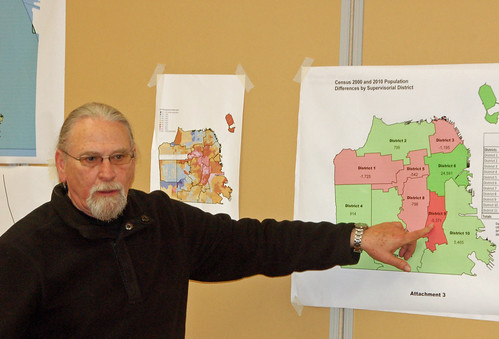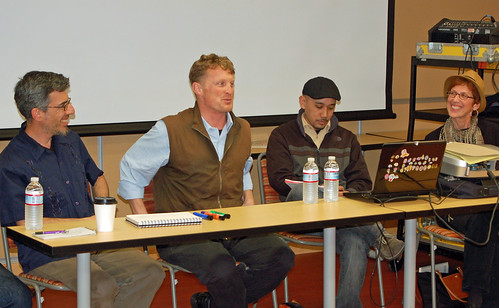The Bay Guardian alternative newsweekly sponsored a meeting last week designed to educate progressive activists about how the process will work to draw local Supervisor's districts and what new maps could mean. The local Redistricting Task Force charged with drawing new boundaries is already working on new maps, holding public hearings. According to the Guardian (and I concur):
While it's difficult to draw 11 bad districts in San Francisco, it's entirely possible to shift the lines to make it more difficult to elect progressives -- something many groups out there are anxious to do.

Community activist Calvin Welsh points to a map of the current districts. Those in red and pink have lost people in the last ten years, while the center-city District 6 has seen massive development and population gains.
The Guardian's meeting sounded a warning that if people don't involve themselves, the prospects for progressive governance might be seriously hurt. A panel included Fernando Marti, who has worked on a draft progressive map; Quentin Mecke, who served on the last redistricting committee; Terry Valen from the Filipino Community Center; and Eileen Hansen, a former Supervisor candidate who later served on the city's Ethics Commission (that's where campaign regulations are enforced.)

This week, the Guardian has posted a link to a proposed progressive community-drawn map. You can see it here.
Having been involved in the last round of this, I'm glad to see community groups trying to engage with the process, although if we have been a little slow to get going. The district boundaries set in the last round helped progressives contest the board of supervisors for most of the decade, balancing citywide administrations that were more friendly to (and funded by) developers and big business interests. Boundaries that corral most of the city's most progressive voters in a few districts would enforce a political balance in which the interests of the very rich sweep aside those of everyone else.
But I was struck by what the two Supervisors who dropped in, John Avalos and David Campos, had to say about the process. Each repeated some version of the statement "we can run in whatever lines they come up with."
Now that's not strictly true; neither man would get far with the voters of Pacific Heights. But the sentiment has to be part of the mindset of progressives who want to influence city politics. We have to present a vision of what life might be like in this city that attracts a majority across its divisions. That's tough in a city where the middle class is being priced out, leaving the rich, the menial workers who serve them, and a sprinkling of short term residents -- young artists, techies and slackers.
Yes, we lose citywide elections because our candidates get buried under an avalanche of cash. But we also lose because we have a hard time projecting a vision that attracts a majority across economic, racial and identity lines. Favorable supervisorial boundaries can to some extent mask a weakness. And the progressive boards elected in the 00s certainly had great accomplishments -- I think particularly of the local universal health plan, Healthy San Francisco. But in addition to good boundaries, we also need that vision thing and the community institutional capacity to spread it.
1 comment:
Yeah, yeah, it's called gerrymandering and they are doing it in Ohio so most districts a red. Guess what? We're raising hell!!
Post a Comment